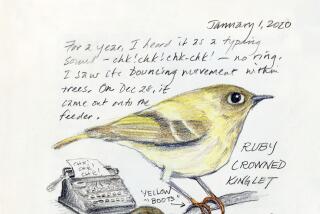Book review: ‘Ape House’ by Sara Gruen
Sara Gruen has carved out a nice little niche for herself novelizing the nexus of humans and the rest of the animal world. She did it most effectively with her 2006 bestseller “Water for Elephants,” which used a Depression-era traveling circus as the vehicle to explore a cast of engaging eccentrics — a tale being filmed for the big screen for next year.
The strength of that novel grew from Gruen’s imaginative blending of human impulses, good and bad, and her re-creation of a specific point in time. It was historical fiction done well, creating believable plots and characters that paralleled real-world events. The net effect was a novel that read as though it could have been true, peopled with characters who moved in understandable ways. The elephant turned out to be a bit player — a device for propelling human behavior.
In her new novel “Ape House,” however, the animals dominate, and the result is not nearly as good. The apes of the title are the endangered bonobos who, along with chimpanzees, are our cousins on evolution’s family tree. Bright and capable of limited language, they also are snicker-inducing for their regular and willful enjoyment of sex. Those three aspects — endangered status, intelligence and sex — come together in Gruen’s novel as a community of bonobos become the object of a reality TV show.
Gruen’s infatuation with the bonobos is palpable. She visited a rescue ranch in Kansas as part of her research and, she writes in her acknowledgements, became smitten. Unfortunately, that engagement seems to have overwhelmed her skills, and here she sounds more like a proselytizer for the Church of the Bonobos than a novelist. Ultimately, her heavy hand sinks the book.
The story centers on Isabel Duncan, an expert at the Great Ape Language Lab, which becomes targeted by animal-rights terrorists. In a “wrong place, wrong time” moment, Duncan is critically injured by a bomb intended to free the bonobos, and the lab’s directors, shaken by the attack, sell the bonobos. Who gets them? A porn producer who sets them up in a house in remote New Mexico and then puts them on live television. America, of course, is transfixed as the exploitation of the animals descends a few rings into Dante’s “Inferno.”
In other hands, this could have been an interesting point of departure for an examination of pop culture and a satire of reality television (OK, it’s already self-satirizing, but still). Gruen’s aim here, though, is to draw attention to the bonobos and to the cruelties inflicted on animals in the name of science, pharmaceuticals and cosmetics. The bonobos are intriguing animals, and efforts to save them in the wilds of the Congo are to be commended. But Gruen’s lack of subtlety isn’t. It’s hard to escape the sense that we’re being lectured to.
The human half of the novel revolves around some clichés and characters with interesting potential. The main players are Duncan, who relates more easily to the animals than to humans for reasons that are never fully explored; and John Thigpen, a downsized journalist from the Philadelphia Inquirer trying to recapture his career by continuing his coverage of the bonobos for a tabloid. Thigpen, of course, is in a marriage headed for the shoals and is attracted to Duncan. The relationship between Thigpen and his wife, Amanda, a novelist who turns to Hollywood, offers the strongest of the side plots. But in the end they never break free of the familiar, either.
The novel’s supporting cast includes bonobo expert Peter Benton, Duncan’s fiancé with a murky past that, by the end of the novel, proves to be the catalyst in the evil doings; and Cat Douglas, a stereotype of the amoral journalist who seeks nothing but the next scoop. Neither is developed as engaging characters. There are also the obligatory fringe figures from the animal-rights world (activist vegan lesbians, a green-haired teen) and legal society (motel-living Russian strippers and the operators of a meth lab in a pizza shop). Yet Gruen never convincingly integrates these characters into the arc of the novel, seeming to drop them in as concocted devices to propel a plot line. Or add a diversionary one.
Still, “Ape House” does have some charms. Animal lovers, particularly, will find much to like in Gruen’s depictions of the apes and the research into their language skills. And we do learn a lot about bonobos. But the book’s failure is in not concocting an engaging story through which to preach the beauty of the bonobos and the darker aspects of animal experimentation. The message is the book’s reason to be, she seems to tell us. But a novel requires more attention be paid to the art.
Martelle is the author of the forthcoming “The Fear Within: Spies, Commies and American Democracy on Trial.”
More to Read
Sign up for our Book Club newsletter
Get the latest news, events and more from the Los Angeles Times Book Club, and help us get L.A. reading and talking.
You may occasionally receive promotional content from the Los Angeles Times.









